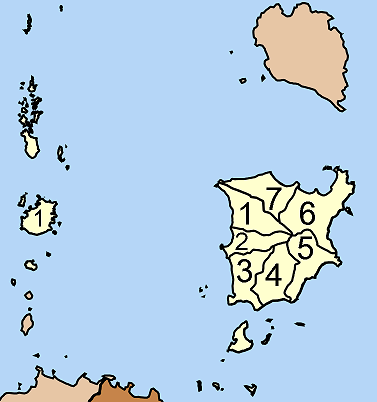Duration of stay: 26th - 28th May 2013
First and foremost, below map is how the Ko Samui Island looks like. Ko Samui is a district in Surat Thani province, subdivided into 7 sub districts, 1. Ang Thong, 2. Lipa Noi, 3. Taling Ngam, 4. Na Mueang, 5. Maret, 6. Bo Phut and 7. Mae Nam. The Seatran ferry terminal is located at sub district no. 1, famously called Nathon area and the hotel that we stayed is at Maenam beach, sub district 7. From a ferry terminal to the hotel is merely 20 minutes drive by taxi.

Ko Samui is reachable by taking 1 and half hour ferry journey from the mainland jetty (Dong Sak). To reach the jetty, there will be about an hour drive from the Surat Thani town centre. For information, a distance from Bangkok to Ko Samui is about 700km. Ko Samui is Thailand's 3rd largest island after Phuket and Ko Chang, with an area of 228.7 km2 and a population of over 62,000 attracting 1.5 million tourists per year.
Ko Samui has abundant natural resources, white sandy beaches, coral reefs and coconut trees being the most significant Island in the Mu Koh Samui Archipelago. The island measures some 25 km at its widest point, surrounded by about 60 other islands, which together compose the Ang Thong Marine National Park (Mu Koh Ang Thong National Park) and include many other popular tourist destinations, including, Koh Phangan, Koh Tao and Koh Nang Yuan.
The island was probably first inhabited about 15 centuries ago, settled by fishermen from the Malay Peninsula and Southern China. It appears on Chinese maps dating back to 1687, under the name "Pulo Cornam". It is said that the name "Samui" is mysterious in itself, a combination of the name of one of the native trees, "mui" and from the Malay word "Saboey", which carries a meaning "safe haven". Whilst, "Ko" is the Thai word for "island". In short, the meaning of Ko Samui is the island of safe haven.
The various lowland and coastal areas are connected by a single 51 km road, running mostly along the coastline and encircling the bulk of the island.The expansion of tourism in Ko Samui has resulted in growth in building resorts, bungalows and luxury private villas on the island, mostly by foreign investors. It has become Thailand's 2nd largest resort business behind Bangkok and surpassing Phuket.
Several ferries connect the island with the mainland, including the aforementioned car/passenger ferries to and from Don Sak (main land) to piers in the west of the island, near or in Nathon. Public buses to all parts of the mainland operate from a small bus station located in the south of Nathon. Songthaews (tuk-tuk style buses) circle the ring road, and private taxis are available throughout the island, although they do not use their meters and sadly to say that taxi fare are quite expensive, for merely 10km distance, the charges is THB500.
Ko Samui is a fairly big island. The most popular and commercialised beaches are Chaweng and Lamai whilst the northern beaches and their adjacent villages of Mae Nam, Bophut and Choeng Mon are more peaceful choices, and the west coast beaches are still (comparatively) quiet.The major reason why people come to Samui is to enjoy the beaches. We spent 2 evenings in Chaweng beach as our hotel is very quite from any sorts of sound.
Remarks: Photos sharing in this entry are taken from both Mae Nam and Chaweng beach. Due to limited public transport and ridiculously higher taxi rate, we spent most of our time enjoying the quite resort life, in peace rather circling the whole island.










No comments:
Post a Comment